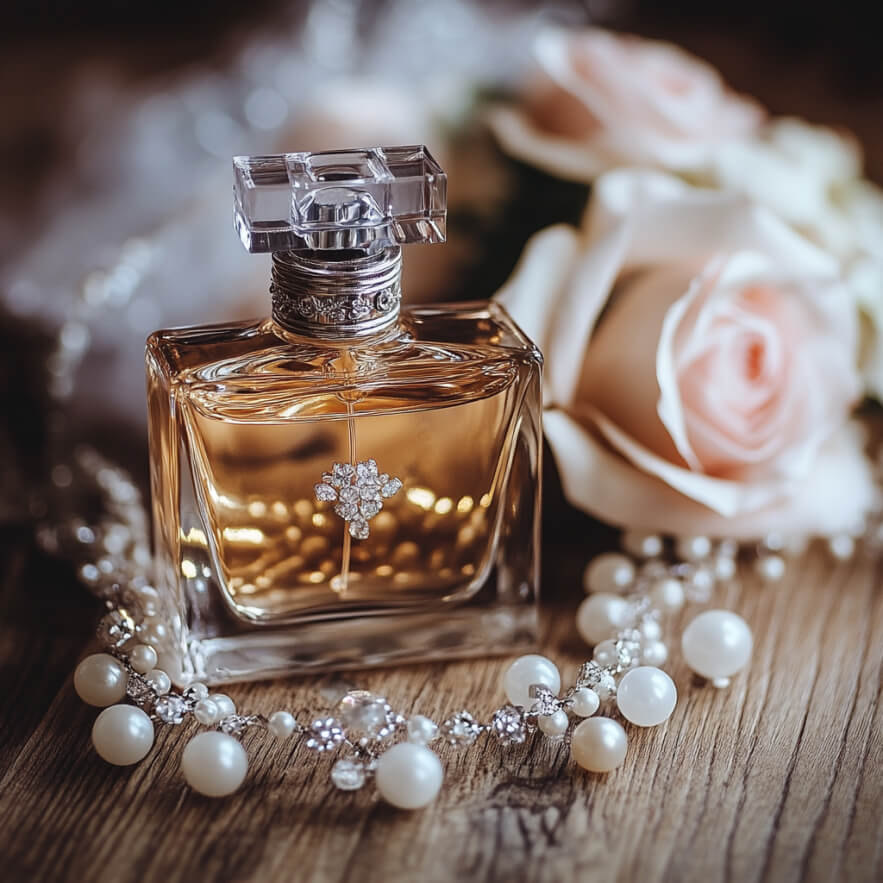Some memories stay not because of how things looked, but because of how they smelled. Fragrance has a direct pathway to emotion—it bypasses logic and settles deep in memory. That’s why adding scent to bridal accessories is more than just a romantic flourish. It’s a strategy for storytelling. Whether subtle or intentional, aromatic details can transform your wedding look into something emotionally layered, multisensory, and deeply personal. The key is knowing where, how, and why to use them.
How fragrance behaves on fabric: choosing the right materials
Different fabrics interact with scent in different ways. Natural fibers like silk, cotton, wool, and linen have porous structures that hold fragrance longer and more evenly. Synthetic materials like polyester, nylon, or satin tend to repel oils and let scent evaporate faster. If you’re planning to apply fragrance to an accessory, choose textiles that can “breathe”—they will absorb and release the scent gently over time.Application matters too. Avoid spraying directly onto fabrics close to the face—like veils or bodices. Instead, store hair ribbons, garters, sashes, or gloves in airtight boxes with blotters sprayed with perfume. This allows scent to settle naturally without staining or overpowering. For more longevity, essential oil dilution in carrier oils like jojoba or fractionated coconut oil can be used to infuse silk flower petals or handkerchiefs for slow diffusion.
Hidden scent capsules: wearable perfumery reimagined
Incorporating fragrance directly into accessories isn’t a new concept—it dates back to ancient Rome, when scent-filled jewelry and garments were used to mask unpleasant urban smells. Modern takes on this include fragrance lockets, perfume rings, and ceramic beads designed to hold scent for hours without touching the skin. Some pieces are refillable; others use porous materials like lava stone or unglazed porcelain.For brides, this opens up a new layer of customization. You can commission a brooch lined with scented wax, a ring with a tiny fragrance chamber, or a bracelet made of essential oil–infused wood. These objects don’t just smell nice—they become signature pieces with emotional resonance. Designers like Maison Balzac, Vintouch Italy, or independent jewelers on JewelStreet offer niche, hand-crafted versions with old-world charm.
Designing a fragrant bouquet: beyond visual beauty
Floral composition is often chosen for aesthetics, but ignoring aroma is a missed opportunity. Botanicals like stephanotis, freesia, tuberose, mimosa, lemon leaf, thyme, and basil add both depth and originality to a bouquet. Many of these plants are also used in perfumery, which makes the scent carry symbolic power. Stephanotis, for example, represents marital happiness—and has a crisp, clean scent that lifts a room.
Dried florals are another subtle option. Lavender, rosemary, chamomile, and eucalyptus retain their smell beautifully and can be used in buttonholes, hair pins, or corsages. They’re lightweight, travel-friendly, and ideal for destination weddings. Pairing fragrant herbs with silk flowers adds both structure and scent longevity, especially for evening ceremonies or humid climates where fresh flowers fade fast.
Embedding scent in heirlooms and symbolic details
Family objects become more personal when layered with scent. An embroidered handkerchief, a grandmother’s glove, or a ribbon from your mother’s wedding bouquet can be infused with a drop of essential oil or your signature fragrance. These items become more than sentimental keepsakes—they become time-bridges. Every time you open the memory box in the future, the scent will return like a breath of the past.This is also a chance to blend new and old. You might pair a modern perfume with a vintage bottle carried in your clutch. Or line a traditional lace veil with invisible aromatherapy beads sewn into the trim. If you’re wearing a piece from a different generation, you can infuse it with a modern scent that represents who you are—creating contrast and continuity at once.
Multi-sensory accessories: pairing texture and aroma
Scent doesn’t live in isolation—it pairs beautifully with other sensory elements. For example, fragrance behaves differently on raw silk, brushed suede, velvet, or bouclé. Choosing textured fabrics that carry scent also helps visually balance minimalist outfits. A simple ivory gown can be elevated with a scented velvet ribbon at the waist or a bouquet handle wrapped in aromatized hemp or lace.
You can also align scent families with visual texture. Green chypre scents work well with matte, structured fabrics. Fruity florals pair with shiny or translucent materials. Oriental or gourmand scents enhance velvet, silk, or brocade. This creates a deeper harmony: people see one thing, smell another—and your bridal presence becomes multidimensional.
Rituals, aromatherapy, and emotional anchoring
Fragrance isn’t just decorative—it can be deeply functional. Many brides now include scent in their wedding day rituals: burning a scented candle while writing vows, brushing perfume through their hair instead of applying it to the skin, or spraying a calming mist in the bridal suite to anchor the moment. This isn’t about performance—it’s about emotional self-regulation through smell.
Aromatherapy principles support this. Neroli calms the heart, bergamot boosts energy, frankincense enhances focus, ylang-ylang lowers anxiety. You can infuse a pocket square, a comb, a boutonniere, or even a pen with essential oil blends that center you. One bride created fabric envelope sachets for each guest, infused with the same scent she wore—tying her presence to their keepsake. Scent isn’t just part of the look. It becomes part of the emotion.
Signature scent layering: anchoring memory in your style
Layering your scent through accessories creates an olfactory signature that’s impossible to replicate. Rather than relying on a single perfume spray, you can build a fragrance experience across different elements. For instance, a base note carried in a wax seal on your vow booklet, a mid note infused into your hair accessory, and a top note misted lightly onto your gloves.This method makes the scent evolve as you move, embracing the space around you without overwhelming it. It’s also ideal for long events where the top notes fade first. Professional perfumers like and boutique ateliers can help you design a wedding scent intentionally built for layering—and accessories become your structure for diffusion.
Natural textiles like silk, cotton, wool, and linen absorb scent well and release it slowly, making them ideal for veils, ribbons, and inner linings.
Yes. Applying diluted essential oils with a cloth or scenting through enclosed sachets avoids staining and respects delicate materials.
Aromatherapy blends like neroli, ylang-ylang, or lavender can calm nerves, enhance focus, and create emotional grounding through scent anchoring

